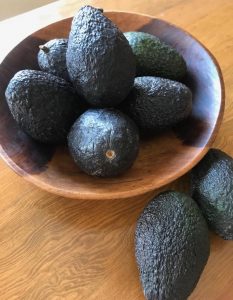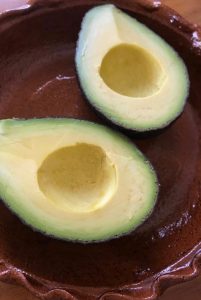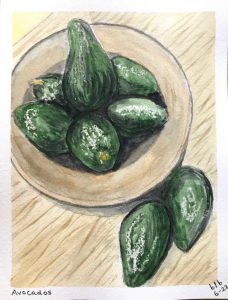In an ongoing effort to keep doctors (even the guapo ones) and hospitals away, I’ve renewed my righteous campaign to eat healthfully every day. Toward that end, I’m planning to eat an avocado a day from now on. Apples are nice, of course, but avos are in another league altogether. They’re considered one of the world’s wonder foods, with more goodness wrapped up in their leathery skins than just about anything.
I’d list for you their nutritional value – all twenty-plus unpronounceable polysyllabic words describing their healthy contents – but your eyes would glaze over. Just trust me. Or Google it. You’ll be impressed. In fact, you’d be hard-pressed to find another food that offers as much healthfulness in such a small, handy package.
Yes, I know avocados are costly now – not just in the U.S. but also here in Mexico, land of avocados. But as my mom would always say, “It’s better to pay the grocer than the doctor.” Good, healthy food is invariably cheaper than medicine. The other day for lunch, for example, I bought a small, ripe Hass avocado at my local tienda (mom-and-pop grocery store) here in San Miguel de Allende for 20 pesos, or about $1 US. Well worth it, I’d say.
Yesterday I went to a larger mercado (market) and bought five good-size avocados for the days ahead for 100 pesos ($5 US). The young woman there explained to me that the price per kilo used to be 80 pesos ($4 US), but is now 120 pesos ($6 US). When I asked why the price hike, she said, “No hay” (there is no), meaning, I assumed, there is a shortage right now. (For a fuller explanation for the price rise here and in the U.S., go to: https://edition.cnn.com/2022/05/05/business-food/avocado-prices/index.html .)

When I lived in Africa and taught health and nutrition as a Peace Corps volunteer in the rainforest of Gabon, I sometimes thought of myself as the Johnnie-Bonnie Appleseed of avocado trees. In the two years I was there, I started dozens of avocado seedlings from pits and gave them to whomever was interested, to plant on their own plot of land.
“Just think,” I’d enthuse to the recipients, “in ten years you’ll have your own avocado harvest! Healthy fruit to feed your family – for free!” That was twenty-five years ago, and I often wonder whether my prophecy came true.
Mexico, as I’ve said, is the land of avocados. Mexico is the world’s largest producer of the crop, supplying about 45 percent of the international avocado market. According to my recent research, avocados are said to have originated in Mexico’s west-central state of Michoacán roughly 10,000 years ago. And here’s a fascinating little tidbit from Wikipedia too:
“The word avocado comes from the Spanish aguacate, which in turn comes from the Nahuatl word āhuacatl, derived from the proto-Aztecan *pa:wa word meaning testicle. The modern English name comes from a rendering of the Spanish aguacate as avogato.”

For those who may be timid about attacking an avocado (and I know from my years of experience as a cooking instructor that there are some who feel this way), here are some helpful tips:
If you don’t need them right away, buy your avocados green, firm, and unblemished; and allow them to ripen at room temperature, preferably in an open bowl on your kitchen counter, for a few days. When ripe, their skin will be dark and they will have some “give” when gently pressed within your hand.
With a sharp knife, carefully cut the ripe avocado in half, lengthwise, and twist it apart. Thwack the blade of the knife into the pit to twist and pull it out. Once your avocados are ripe – and before you cut them open – they can be refrigerated for a few days before using.
And here are a few ideas for super-easy avocado eating:
- Generously slather some toast with the buttery ripe avocado flesh and sprinkle with salt. Many people call this breakfast.
- Fill the cavity of the avocado half with balsamic vinegar and sprinkle with salt. You can call this your side salad.
- Mash the ripe avocado in a small bowl, add some bottled salsa verde (I use Herdez brand), and mix well. Call this your guagamole and serve it with tortilla chips.
So perhaps you’d like to join me in eating more healthfully in the coming months by adding an avocado to your daily diet? And maybe even go one step further and paint a still life of your own beautiful, healthful avocados, just for the joy of it?

